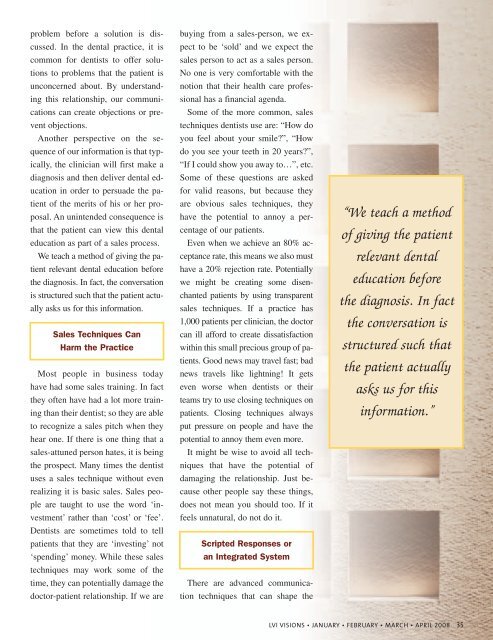Create successful ePaper yourself
Turn your PDF publications into a flip-book with our unique Google optimized e-Paper software.
problem before a solution is discussed.<br />
In the dental practice, it is<br />
common for dentists to offer solutions<br />
to problems that the patient is<br />
unconcerned about. By understanding<br />
this relationship, our communications<br />
can create objections or prevent<br />
objections.<br />
Another perspective on the sequence<br />
of our information is that typically,<br />
the clinician will first make a<br />
diagnosis and then deliver dental education<br />
in order to persuade the patient<br />
of the merits of his or her proposal.<br />
An unintended consequence is<br />
that the patient can view this dental<br />
education as part of a sales process.<br />
We teach a method of giving the patient<br />
relevant dental education before<br />
the diagnosis. In fact, the conversation<br />
is structured such that the patient actually<br />
asks us for this information.<br />
Sales Techniques Can<br />
Harm the Practice<br />
Most people in business today<br />
have had some sales training. In fact<br />
they often have had a lot more training<br />
than their dentist; so they are able<br />
to recognize a sales pitch when they<br />
hear one. If there is one thing that a<br />
sales-attuned person hates, it is being<br />
the prospect. Many times the dentist<br />
uses a sales technique without even<br />
realizing it is basic sales. Sales people<br />
are taught to use the word ‘investment’<br />
rather than ‘cost’ or ‘fee’.<br />
Dentists are sometimes told to tell<br />
patients that they are ‘investing’ not<br />
‘spending’ money. While these sales<br />
techniques may work some of the<br />
time, they can potentially damage the<br />
doctor-patient relationship. If we are<br />
buying from a sales-person, we expect<br />
to be ‘sold’ and we expect the<br />
sales person to act as a sales person.<br />
No one is very comfortable with the<br />
notion that their health care professional<br />
has a financial agenda.<br />
Some of the more common, sales<br />
techniques dentists use are: “How do<br />
you feel about your smile?”, “How<br />
do you see your teeth in 20 years?”,<br />
“If I could show you away to…”, etc.<br />
Some of these questions are asked<br />
for valid reasons, but because they<br />
are obvious sales techniques, they<br />
have the potential to annoy a percentage<br />
of our patients.<br />
Even when we achieve an 80% acceptance<br />
rate, this means we also must<br />
have a 20% rejection rate. Potentially<br />
we might be creating some disenchanted<br />
patients by using transparent<br />
sales techniques. If a practice has<br />
1,000 patients per clinician, the doctor<br />
can ill afford to create dissatisfaction<br />
within this small precious group of patients.<br />
Good news may travel fast; bad<br />
news travels like lightning! It gets<br />
even worse when dentists or their<br />
teams try to use closing techniques on<br />
patients. Closing techniques always<br />
put pressure on people and have the<br />
potential to annoy them even more.<br />
It might be wise to avoid all techniques<br />
that have the potential of<br />
damaging the relationship. Just because<br />
other people say these things,<br />
does not mean you should too. If it<br />
feels unnatural, do not do it.<br />
Scripted Responses or<br />
an Integrated System<br />
There are advanced communication<br />
techniques that can shape the<br />
“We teach a method<br />
of giving the patient<br />
relevant dental<br />
education before<br />
the diagnosis. In fact<br />
the conversation is<br />
structured such that<br />
the patient actually<br />
asks us for this<br />
information.”<br />
<strong>LVI</strong> VISIONS • JANUARY • FEBRUARY • MARCH • APRIL 2008 35


